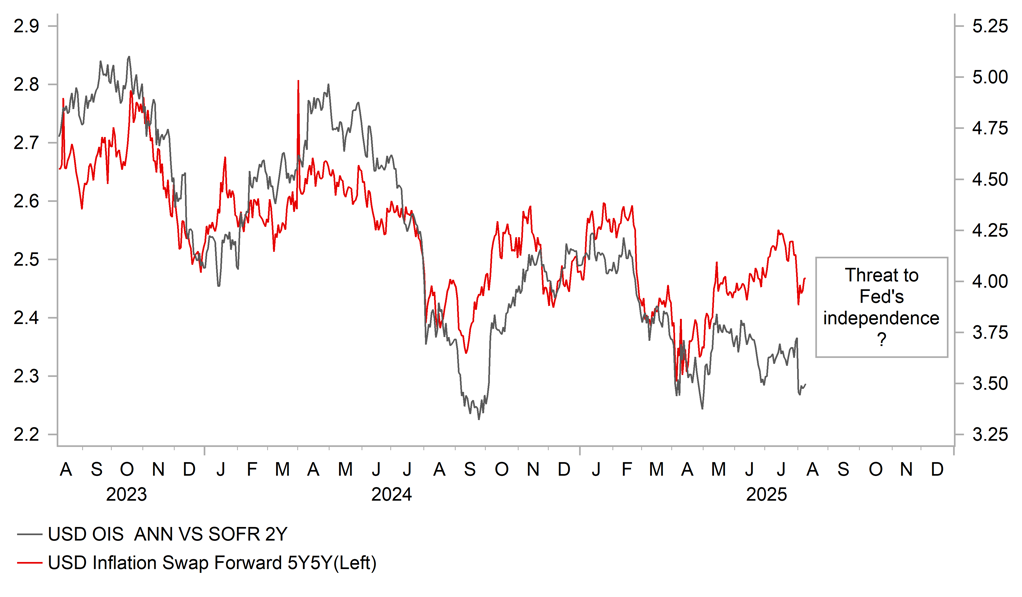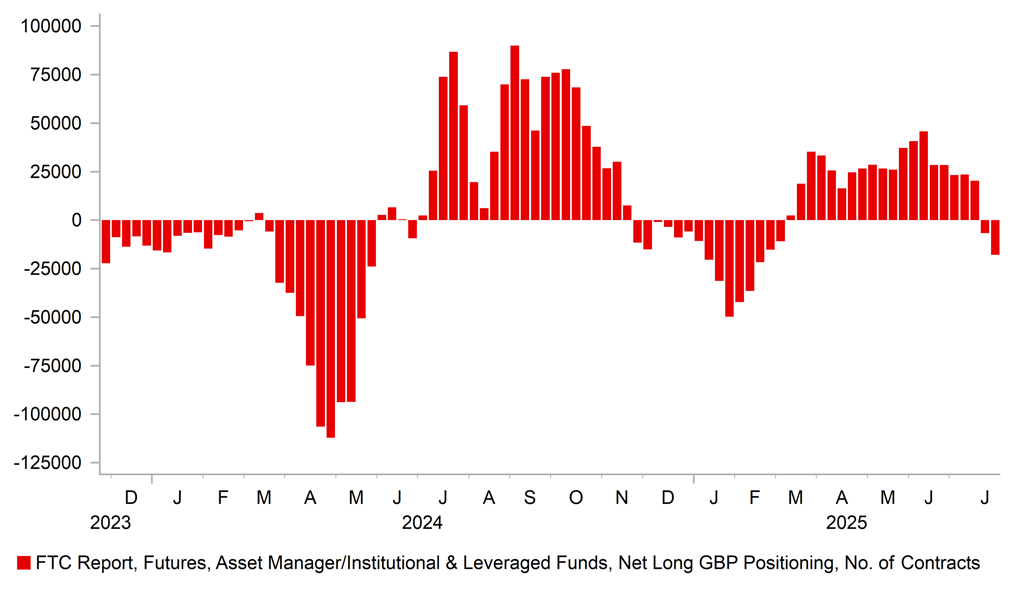Trump takes more cautious step and time on Fed Chair
USD: Waller moves to favourite helping dollar
Much of the focus this week has been on who President Trump would pick to replace Adriana Kugler as Governor after her resignation last week, which is effective after today. A decision to replace Kugler with someone on a permanent basis would have strongly signalled that person being positioned in order to take over from Fed Chair Powell in May. The temporary appointment of Stephen Miran can therefore be viewed as leaving the current Fed Governors in the running for the position. Christopher Waller now appears to have moved into a strong position to take over from Powell. This should be viewed more positively by the financial markets than say Kevin Hassett who is deemed as very close to President Trump and with less experience.
A choice of Waller is therefore more US dollar supportive than a choice of Kevin Hassett. However, there are still a number of uncertainties. Miran is deemed as one of Trump’s more aggressive policymakers and is known for his infamous article suggesting a new FX accord and the need for a weaker US dollar. He is also critical of those who link tariffs to higher inflation and will certainly, once in place, be voting for the FOMC to cut rates. One uncertainty is whether or not he will be in place for the September FOMC meeting. The Senate reconvenes on 2nd September and the FOMC meeting is on 16th/17th September. That’s a tight turnaround for Senate confirmation but we see this as very doable especially if it has been confirmed this will be only a temporary holding position until Kugler’s term expires on 31st January. Having Miran in place by that meeting certainly makes a rate cut at that meeting more likely – the market is currently implying a 90% probability of a 25bp cut in September. The US dollar did reverse most of the modest gains recorded yesterday on the news of Miran taking the position temporarily although some of those losses have been reversed again today. That back-and-forth is understandable. Miran is still just one vote, he won’t have much influence give his position is temporary and the rest of the FOMC has already been shifting more dovishly following the weak payrolls report last week.
Furthermore, the bigger picture of Waller moving into the position as favourite to take over from Powell is a positive. That’s not a done-deal though and the pick to replace Miran from the end of January will be important and could see that person suddenly become the obvious candidate to take over. The January 2026 FOMC takes place on 28th January, just before Kugler’s board position expires at month-end meaning Miran, if confirmed prior to the September FOMC meeting will attend four FOMC meetings. The OIS market is close to priced for three 25bp rate cuts over those four meetings which certainly reflects already the prospect of a weak labour market and more Fed officials being open to easing policy. So Miran’s influence given market expectations already will be marginal. Still, the choice of Miran – someone very close to Trump – is a signal that Trump’s permanent pick will likely be some close and loyal which will certainly be a factor we think that will weigh on US dollar performance.
FED RATE EXPECTATIONS LOWER BUT INFLATION EXPECTATIONS HIGHER

Source: Macrobond & Bloomberg
GBP: A divided MPC swings back to inflation risk focus
The pound advanced by about 0.7% yesterday and after a period of underperformance since the start of H2, was the top performing G10 currency yesterday. The least surprising aspect of yesterday’s MPC decision was the evidence of division. That’s been a consistency for some time now and yesterday’s vote confirmed there still has not been an unanimous vote since the current tightening cycle began. The last unanimous vote was when the policy rate was held at 0.10% in September 2021. The initial vote yesterday of 4-4-1 meant there was no majority for a decision either way and hence Alan Taylor, the sole voter for a 50bp cut switched to 25bps to give us a 5-4 vote to cut by 25bps. Relative to the May vote (2-5-2) it meant there was a larger number looking for no change and one fewer voting for a larger 50bp cut.
We covered the outcome of the meeting yesterday in an ad hoc piece (here) and our main conclusion was that while this was a hawkish outcome relative to expectations, the follow-through in terms of pound buying is likely to be relatively limited. The outperformance may last a little longer but this likely reflects the unwind of short pound positions that had been built up in recent weeks. The weekly IMM positioning data has seen Asset Managers & Leveraged Funds’ positioning in the space of seven weeks turn from the largest long position since October last year to the largest short position since February.
The primary source of concern over inflation was due to food and energy, which is part of the reason behind inflation expected to increase further to 4.0% by September. The previous peak was estimated in May to be 3.6%. But prior communications from the MPC pointed to the main risk stemming from the labour market but softer jobs prints had increased confidence amongst MPC members of a decline. Yesterday, the MPC still expressed confidence that wage growth would “slow significantly over the rest of the year”. In that sense it was somewhat surprising to suggest that food and energy prices risked seeing wage growth pressured to the upside. As Governor Bailey stated in an interview afterwards, the MPC need to focus on the “consequentials” of the rise in inflation that is currently taking place. It meant the decision and risks both ways are “finely balanced”. The MPC also highlighted the reduction in the level of restrictiveness and estimated that the impact of tight monetary policy was likely now peaking meaning policy going forward, even if left unchanged, would become less restrictive as the lag of previous tightening passes.
The result of the MPC announcement is that the rates market now only sees a rate cut in November as a 50-50 chance. Prior to the meeting it was priced implying about a 75% probability. We still expect the BoE to cut in November. There was nothing in the MPC forecasts about the potential large tax increases to come to tackle a growing fiscal hole (NIESR estimates GBP 51bn). Whether it is that size or not, the uncertainty itself could well do further damage. We already know from the GfK Consumer Confidence report that households’ appetite to save is the highest since 2007. Growth risks still look skewed to the downside and we also see increased risks of global investors seeing tariffs as a bigger global growth risk once we get into September/October time that would also weigh on GBP performance. We are maintaining our trading view of long EUR/GBP with upside scope intact despite yesterday’s decline.
SHORT-TERM POSITIONING CHANGES IMPLIED GBP SELLING IN THE WEEKS AHEAD OF YESTERDAY’S BOE MEETING

Source: Macrobond & Bloomberg
KEY RELEASES AND EVENTS
|
Country |
BST |
Indicator/Event |
Period |
Consensus |
Previous |
Mkt Moving |
|
SZ |
08:00 |
SECO Consumer Climate |
Q3 |
-30 |
-39 |
! |
|
UK |
12:15 |
BoE MPC Member Pill Speaks |
-- |
-- |
-- |
!!!! |
|
CA |
13:30 |
Avg hourly wages Permanent employee |
Jul |
-- |
3.2% |
! |
|
CA |
13:30 |
Employment Change |
Jul |
15.3K |
83.1K |
!!! |
|
CA |
13:30 |
Full Employment Change |
Jul |
-- |
13.5K |
! |
|
CA |
13:30 |
Part Time Employment Change |
Jul |
-- |
69.5K |
! |
|
CA |
13:30 |
Participation Rate |
Jul |
-- |
65.4% |
! |
|
CA |
13:30 |
Unemployment Rate |
Jul |
7.0% |
6.9% |
!!! |
Source: Bloomberg & Investing.com
